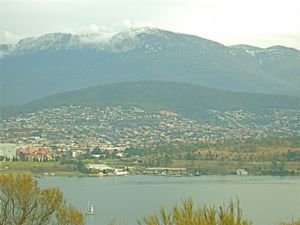KNOCKLOFTY HISTORY
A COLOURFUL HISTORY

Knocklofty from Eastern Shore
Knocklofty reserve has been used for timber, sub divided for grazing, excavated for sandstone, developed as a major brick-making site and urbanised by the construction of two reservoirs.
The reserve covers 155 hectares of mostly natural bushland and links the city to Wellington Reserve. It is a refuge for native animals and plants, some of which are threatened or endangered, and for the many birds that are displaced by clearing and residential development.
Knocklofty is now a valuable area of urban bushland, and a popular place for community to enjoy. Much of what you see in the reserve today - healthy thriving native bushland - is due to the ongoing efforts of the Friends of Knocklofty Bushcare Group [FoKL], in partnership with the Hobart City Council and their Bushlands group.
Evolving from a meeting of dynamic local people back in 1992, the group have worked tirelessly for sixteen years to restore, protect and value the reserve. In these sixteen years, 95% of the reserve has been cleared of woody weeds, in particular gorse, blackberry and broom, and 30,000 local provenance native plants have been planted in areas devastated by weeds, fire and overgrazing.
PRE-EUROPEAN HISTORY
Before the arrival of Europeans, Tasmanian Aborigines called the area around Hobart Nibberloone or Linghe. it was the territory of the Mouheneer band of the South East Nation. The Mouheneener people were one of several bands living on the western bank of the Derwent River. Aboriginal people would have used the reserve and surrounding hills and mountains, draped in natural vegetation and rich in plants and animals to provide their families with food, medicine and other necessities for thousands of years. Due to the many alterations to the landscape of the Knocklofty Reserve, today we can only surmise the extent of Aboriginal occupation within the reserve; however, we do know that they used rock shelters in the vicinity.
WOODCUTTING
The first settlers of Hobart Town arrived in 1804. By 1829, when the settlement was still largely confined to a few blocks, the hill behind the town had already been completely cleared for firewood and building timber, which earned it the name of Woodman's Hill
QUARRYING
Quarrying of sandstone was a major industry on the eastern slopes of Knocklofty where Rippon Shields operated the stone quarry for many years. Many of the fine buildings in Hobart were constructed from sandstone quarried on Knocklofty, including the public buildings, major banks and churches and also many of the humble cottages.
BRICK MAKING
Knocklofty was one of the major brick making sites in Hobart. Rippon Shields established brickworks at Knocklofty in 1882 in response to a shortage of bricks. By 1915 Crisp & Gunn operated a brick works in what is now the Aussat quarry, which continued in a small way until 1965 when the old works finally closed, and all the buildings were demolished including, most spectacularly, the last tall chimney.
OWNERSHIP
The reserve was owned privately until 1942 when it was purchased by the Hobart City Council. This thwarted a plan to recommence timber cutting on the reserve. The City of Hobart Plan of 1945 stated "The immediate timber-clad backgound of the city has been preserved by the action of the City Council in purchasing the slopes of Mount Knocklofty".
RECREATION
Knocklofty has always been a popular picnic and recreation area. An early John Glover painting, which hangs permanently in the Colonial Gallery of the Tasmanian Museum and Art Gallery, shows some hunters coming into the reserve from Poets Road on what is now the Glover track. This area was a popular destination for artists in the early days and many of them painted a view over the city from the Reserve.
RECENT PAST
Although Knocklofty was reserved for the use of the people of Hobart from 1945 onwards, it was neglected and mismanaged for many years. It became so degraded and choked with gorse and broom that when the old green was cleared in 1975 bulldozers were used to clear the gorse. Annual burns of the gorse and broom and frequent wildfires prevented the development of the heathy plant species, which once characterised Knocklofty. They also weakened the vigour of the trees. In 1983 a management plan was adopted which recognised the poor state of the area. A programme was put in place to begin the removal of weeds and the regeneration of the native plants. Also at this time tracks were upgraded to encourage visitors back to the reserve